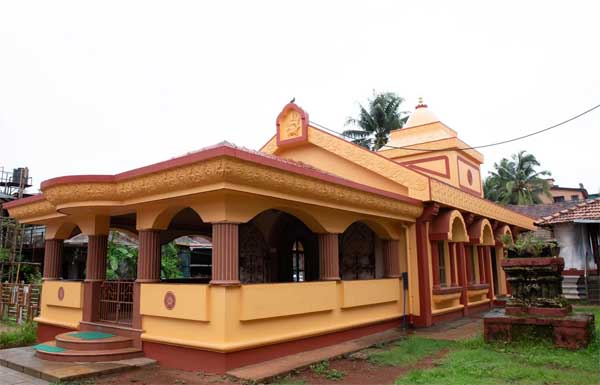Devaki Krishna Temple at Marcel in Goa is a rare temple where Mother Devaki is worshipped along with child form of Bhagavan Sri Krishna. Shree Devakikrishna Ravalnath Saunsthan is among the earliest temples established by the Saraswat community in Goa, attributed to the legendary Lord Parshuram. The exact founding date is challenging to determine, as much of the temple's history remains obscure, passed down through songs and tales preserved by a dwindling group of devotees.
Marcel Devaki Krishna Temple Story
The story of Devaki and Krishna can be traced back to the
Mahabharata, with a notable reference to the Gomanchal Parvat, where a fierce
battle unfolded between Krishna and Balaram on one side and Jarasandha and his
supporters on the other.
Jarasandha was so formidable that Krishna sought refuge on
Gomanchal Parvat, fleeing from the north. This separation caused Devaki,
Krishna's biological mother, great distress, and she embarked on a journey
southward to Gomanchal Parvat, desperate to reunite with Krishna. When they
finally met, Devaki couldn't believe her eyes, suspecting some malevolent
forces were deceiving her and endangering Krishna's life. Krishna, realizing
that he hadn't met his mother since his childhood departure for Dwarka,
appeared as a young child to her, embracing her, and Devaki lifted him onto her
lap.
The story of Devakikrishna has its origins in sacred texts,
and the symbolic murti (idol) is a rare and unique representation. The meeting
place, Chudamani Island on Chorao (or Chodan), was once a dense forest where
Krishna had hidden. Remnants of the old Chodan temple can still be found today.
To protect the temple from Portuguese attempts to destroy it, it was relocated
to Mayem. When the Portuguese captured Bicholim taluka, of which Mayem was a
part, the murtis (idols) were moved to Marcela or Mashel through the Kumbharjua
canal in canoes.
Devakikrishna's temple was not the only one targeted by the
Portuguese, leading to large-scale migrations of Hindus to safer regions within
and outside Goa. These migrants carried with them the most precious symbols of
their family deities. The destruction phase, lasting nearly five centuries, was
a nightmare for the community. However, in the 17th century, the Saraswat
community resurged and reconstructed many temples, reinstalling deities and
prospering as safe institutions. They assimilated with the locals, fostering
cordial relationships.
Followers of Devakikrishna accommodated Ravalnath and
Bhumika within their fold, establishing harmonious and brotherly relationships.
This is why you can find devotees from various communities at many temples. The
temple dedicated to Devakikrishna in Mashel is unique, although there are a few
temples with similar idols elsewhere, often established by those unable to
visit the main temple regularly. These branches still consider the deity at
Mashel as their primary source of inspiration and visit it occasionally. With
improved transportation and the passage of time, the gap is narrowing, and it's
only a matter of time before the temple regains its former glory.
Marcel Devaki Krishna Temple Festival
The annual Zatra of Shri Devkikrishna takes place in the
month of Margashirsha on the Shukla trayodashi, which is the thirteenth day of
the first half of the month of Margashirsha. During the festival known as
'Shibikotsav,' Lord Shri Krishna is depicted in his mother's lap, and when he
is portrayed in a chariot, he is seated alone. The idol of Lord Shri Krishna in
the chariot is made of blackish ('shyamavarnni') Tulsi wood and is incredibly
captivating and eye-catching. Throughout the year, except during the
'Chaturmas' period, 'Shibikotsav' is celebrated fortnightly, specifically on
the day of 'trayodashi.' This frequent observance highlights the special
importance of this particular day in the temple's calendar.
Traditionally, the significance of 'Ashttami' or the eighth
day might seem more logical for Lord Krishna's observance or festivity.
However, some speculate that when the deity was initially installed on
Chudamani or the Chodan island in ancient times, it might have coincided with
the thirteenth day. Alternatively, during the process of relocating the deity
to Mashel via Mayem and eventually establishing it in Mashel, these days may
have continued to align with the 'trayodashi.'
It's worth noting that the thirteenth day or 'trayodashi'
holds special significance in Hindu Dharmashastras. An ancient tradition
proclaims, "trayodashi sarvasiddhi," suggesting that the thirteenth
day is the most auspicious for achieving all accomplishments. This belief
remains popular among Hindus to this day.
‘Dahikala’ and ‘Gaulankala’ are observed on the day after
Sri Krishna Jayanti.

